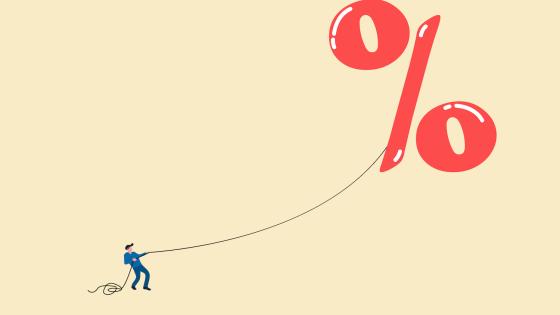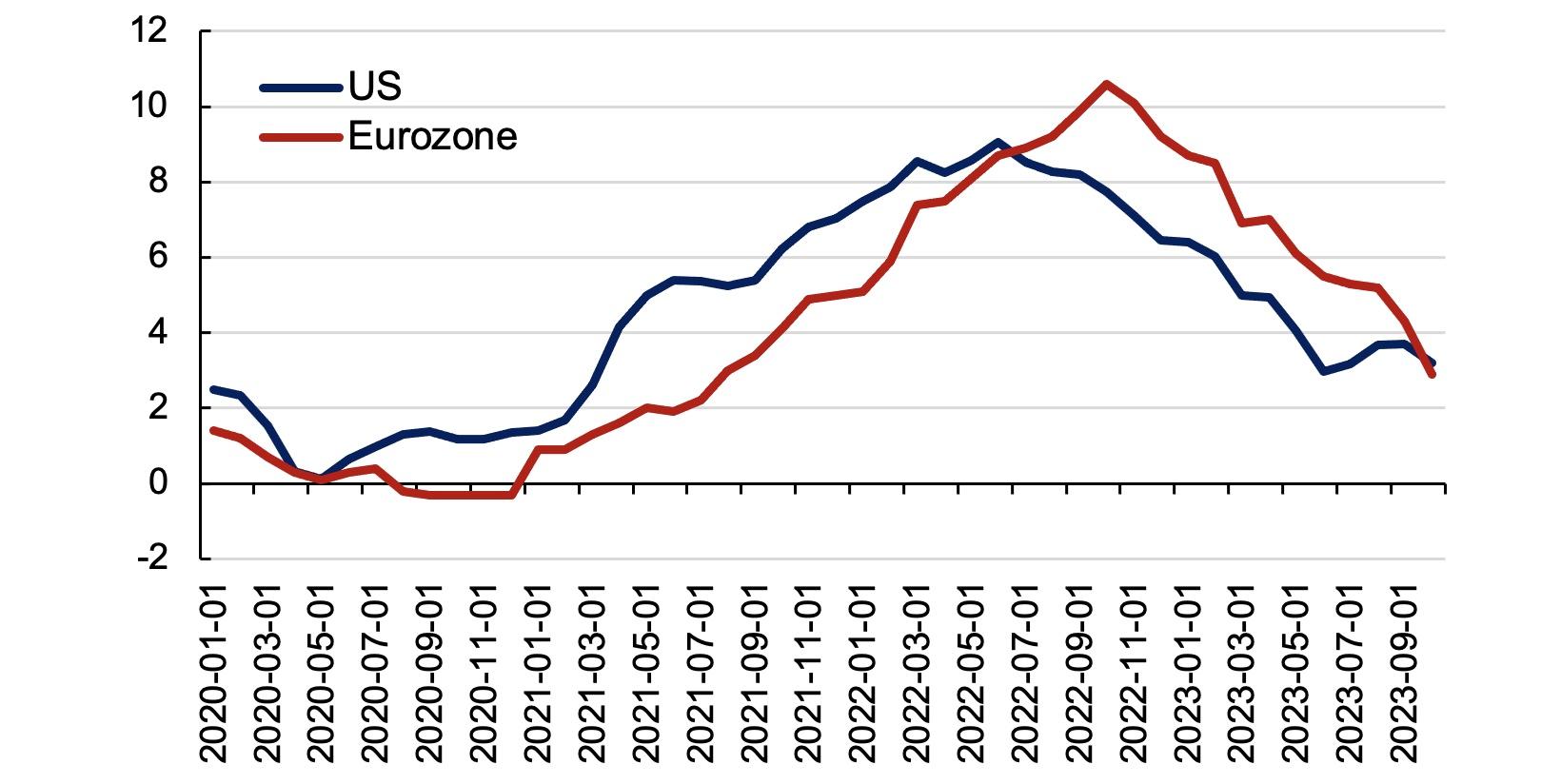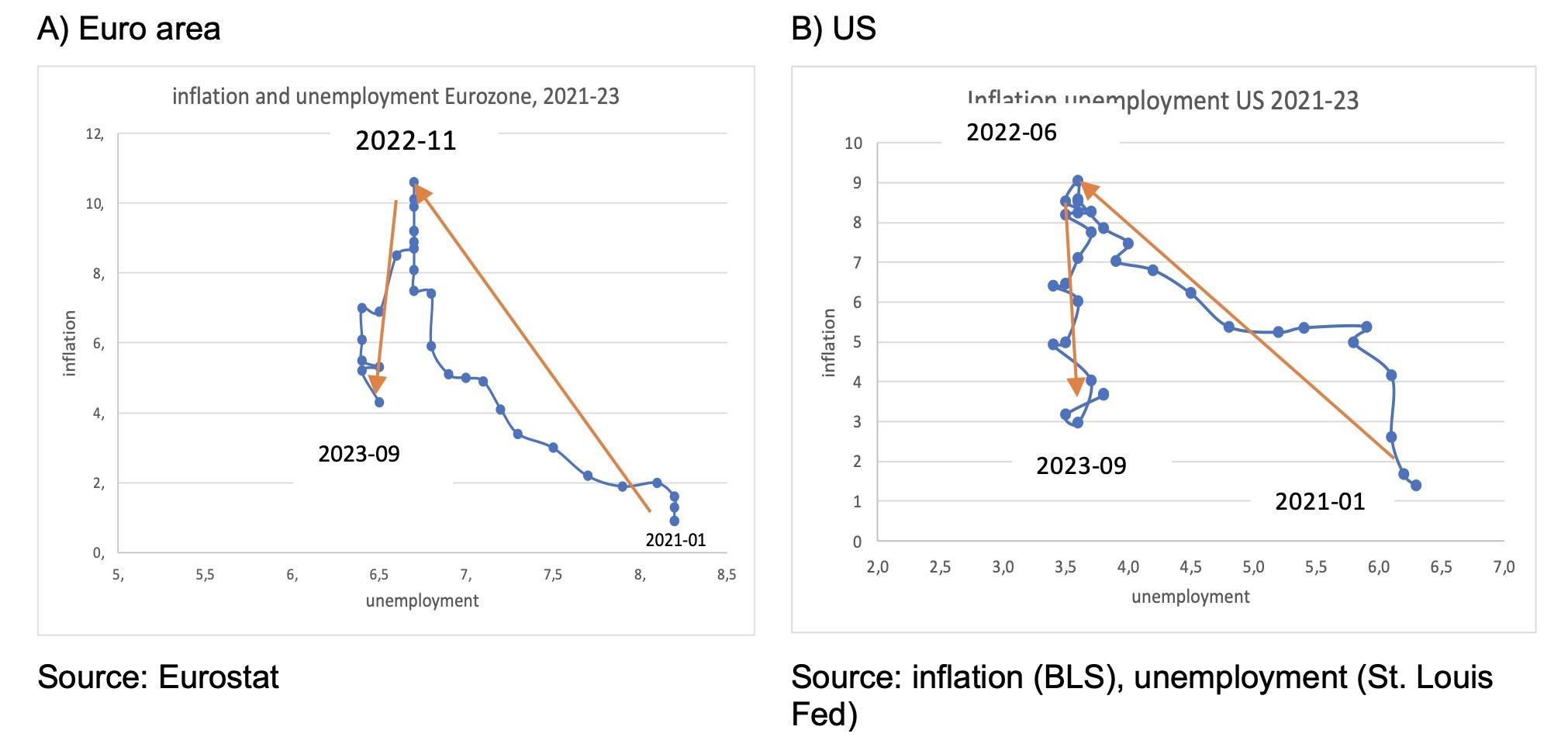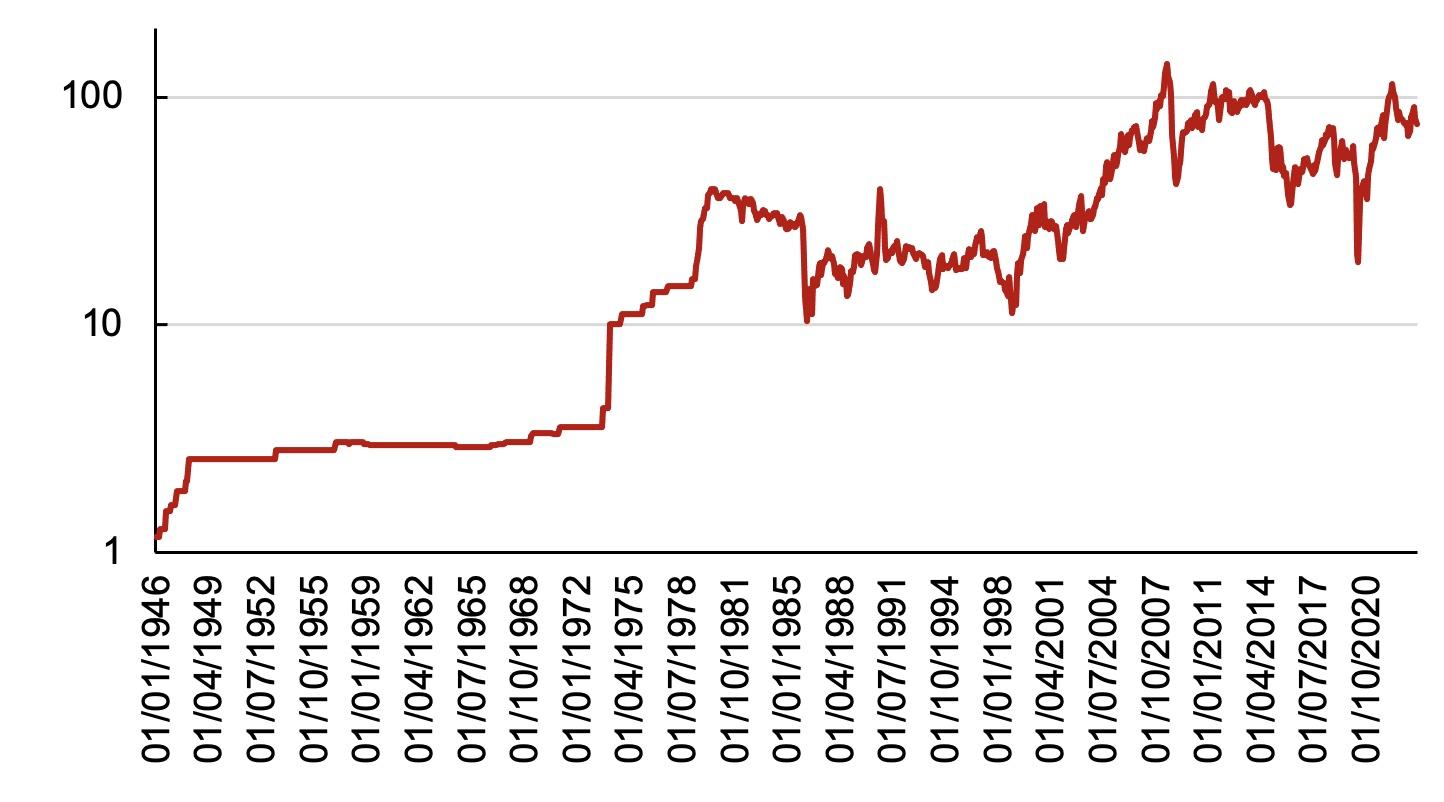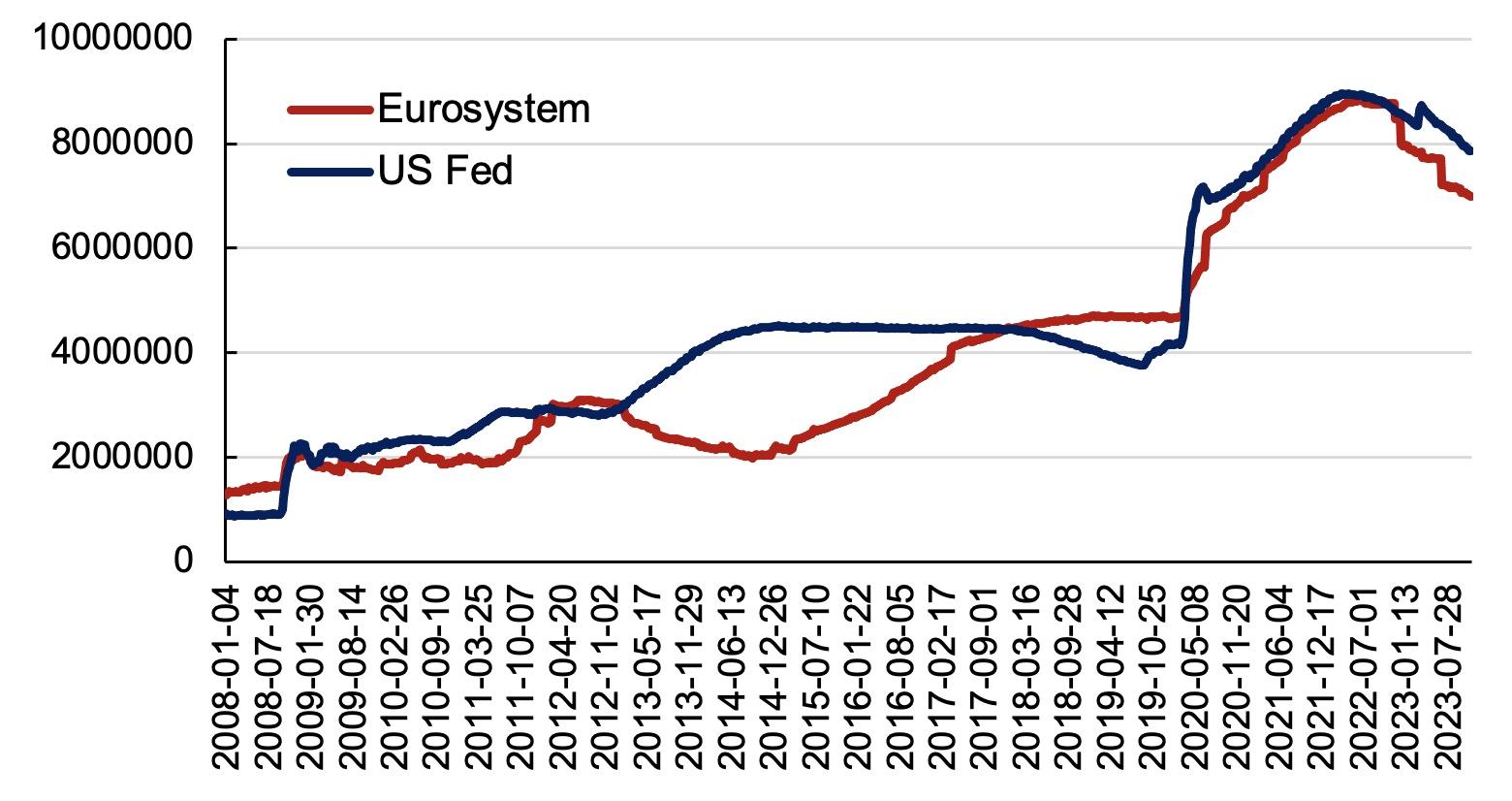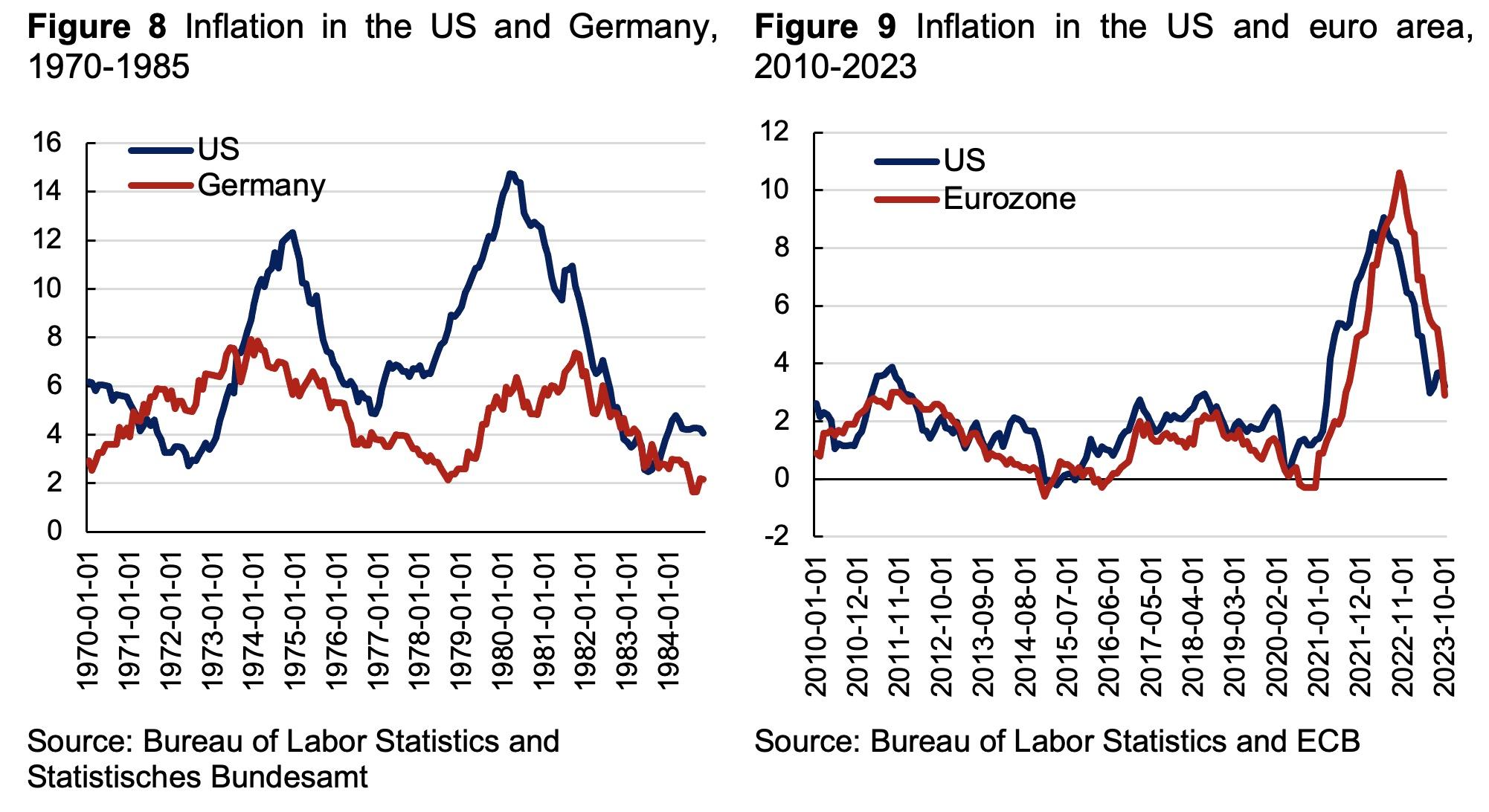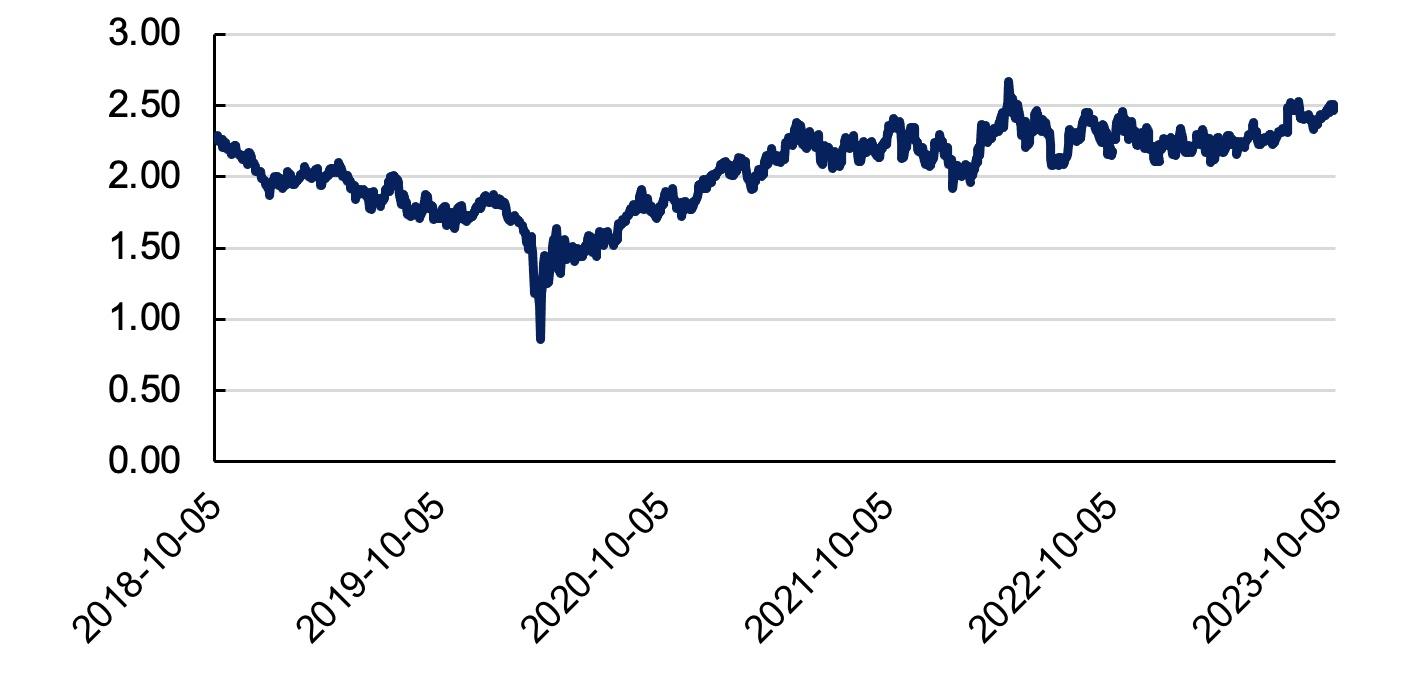The inflation that emerged in 2021 in the US and the euro area was extremely fast and quickly led to a spike of more than 9% in the US and 10% in the euro area (see Figure 1). Equally remarkable is the speed with which inflation has declined since reaching these peaks. In fact, the rate of decline was even quicker (until now) compared to the rate of increase. In October 2023, inflation had dropped to 3.2% in the US and 2.9% in the euro area, a fraction of the peaks reached during 2022. This leads to the issue of the sources of the recent inflationary surge.
Figure 1 Inflation in the US and euro area, 2020-2023
Source: Bureau of Labor Statistics and European Central Bank.
To understand the nature of the current inflation phenomenon it is useful to compare it to the inflationary environment of the 1970-80 period. This is what we intend to do. We compare the recent inflationary surge to the one that occurred during the 1979-80 period. By contrasting these two periods we hope to shed light on the nature of the most recent inflationary episode. (For other such comparisons see Kose et al. 2022, Kammer et al. 2023).
Trade-offs between inflation and unemployment
We start by comparing the trade-offs between inflation and unemployment in the current period with the one obtained during the 1979-85 period (see Ball et al. 2022, Cerrato and Gitti 2023 on trade-offs). We show the results in Figures 2 and 3. Figure 2 shows the trade-off between inflation and unemployment during the 1979-85 period in Germany and the US. We selected Germany as representing the euro area countries at that time. In Figure 3 we present this trade-off in the euro area and the US during 2021-23.
The most striking feature of a comparison between the two figures is that the nature of inflationary surge was very different in the two periods. During the 1979-85 period the movement was clockwise. In the first stage there was a surge in inflation coinciding with a large increase in unemployment in Germany and in the US (but also in most other European countries). We observe that the German inflation increased from 2.5% in January 1979 to almost 8% in October 1981 while unemployment doubled over the same period. Similar increases are observed in the US. In the second stage the anti-inflationary policies of the central banks started to bite, and inflation dropped. But during this second stage unemployment continued to increase dramatically. There is also a third stage. This is when unemployment started declining again. This stage was reached in the US at the end of 1982. It took Germany much longer to reach this stage. At the end of 1985 Germany had not yet reached it. This only happened in the second half of 1980s (not shown here).
The recent inflationary surge was very different in nature. The movement in the inflation-unemployment space is now counter-clockwise. The inflationary surge that started at the beginning of 2021 (first stage) coincided with a strong decline in unemployment in both the US and the euro area. During the second stage that started in the second half of 2022, inflation dropped significantly while unemployment remained more or less constant.
How can we make sense of this? We will answer this question by focusing first on the nature of the shocks hitting these countries during these two periods. Then we will discuss the initial conditions that existed when the shocks occurred.
Figure 2 Inflation-unemployment trade-offs during 1979-85
Figure 3 Inflation-unemployment trade-offs during 2021-23
Nature of shocks
The 1970s were characterised by massive supply shocks. Oil prices increased by a factor of ten from the early 1970s until the end of the 1970s. In 1979 alone they more than doubled. We know from economic theory that a negative supply shock leads to an increase in prices and a decline in output, the latter then typically leading to more unemployment. This is what happened in the 1970s and is illustrated in the trade-off Figure 2.
The recent experience suggests that the source of inflation was a positive demand shock. Economic theory tells us that such a shock leads to higher prices and higher output (and thus less unemployment). This is what we observe during 2021-23 (see Figure 3). Thus, judging from Figures 2 and 3 the period 1979-85 was characterised mainly by a large supply shock, while the recent period seems to be dominated by a large demand shock.
The previous analysis leads to the question of how we square the diagnosis of the recent period as a demand shock with the observation that during that period there were also large negative supply shocks? These negative supply shocks arose from the disruptions of supply lines during the pandemic and from very large increases in gas prices, and to a lesser extent oil prices. We show the evidence in Figures 4 and 5.
Figure 4 shows the evolution of the natural gas price. The gas price increase was very large surging by a factor of five in a few months’ time to reach a peak in August 2022. However, it is equally sensational how quickly it declined. Thus, this was a large supply shock, but also a very temporary one. The steep decline after August 2022 is one of the factors explaining why inflation declined fast from the autumn of 2022 on, especially in the euro area that is more dependent on the gas prices.
The evidence of oil prices (Figure 5) suggests two things. First when comparing the 1970-80 period to today it is striking to find how large the oil price increases of the 1970s were. During that period oil prices increased by a factor of more than ten (from about $3 a barrel in 1970 to $39 per barrel in 1981). In contrast, the recent oil price increases were no higher than the ones observed during 2005-08 and 2010-12. Second, the oil price increases in the 1970s had a permanent character. After the surge during the 1970s the oil prices never returned near to the level that existed prior to the surge. This contrasts with the post-pandemic period: the changes observed since the pandemic have been around the levels of the oil prices achieved since 2000.
We conclude that indeed there were supply shocks after 2020, but in contrast to the 1970-80 period, they were less substantial and more importantly they were temporary.
Figure 4 Natural gas price (dollars)
Figure 5 Crude oil price (dollar per barrel), log scale
The demand shock that occurred in the period 2020-22 found its origin in the massive fiscal stimulus programmes initiated by the budgetary authorities during the pandemic. We show these in Figure 6 which presents the cyclically adjusted primary budget balances in the US and in the euro area. During 2020 both countries engaged in fiscal impulse programmes that exceeded more than 5% of GDP (see Summers 2021 and Landau 2021 on this).
Figure 6 Cyclically adjusted primary budget balance (% of potential GDP)
Source: OECD
In addition, these massive fiscal expansions were monetised by the central banks of these two countries. Both the US Fed and the ECB bought large amounts of government bonds during the same period. We show the evidence in Figure 7. From February 2020 until the end of 2021 the Fed bought about $5 trillion and the ECB €4 trillion of government bonds, thereby doubling the size of their balance sheets. These purchases exceeded the cumulative budget deficits of the US government and of the governments of the euro area. It was a textbook case of a large budgetary expansion financed by monetary means. And as these textbooks make clear it is not really surprising that this leads to a surge of inflation.
Figure 7 Balance sheets of US Fed and Eurosystem (million US dollars or euros)
Source: US Federal Reserve and Eurosystem
Initial conditions
The initial conditions that existed when inflation surged in 1979 and when it did in 2021 were very different. Preceding the supply shock of 1979 there had been a build-up of inflation and inflationary expectations (see Figure 8). The shocks that occurred during 2020-22 were preceded by a period of low inflation (see Figure 9). This difference is important. It made it possible for inflationary expectations to remain anchored at a relatively low level during the recent inflationary episode. This is confirmed by Figure 10 for the US which shows the implicit inflation expectations obtained from inflation swap rates. We observe that throughout the 2021-23 period inflationary expectations remained anchored close to 2% despite the fact that inflation had surged dramatically. A similar phenomenon was observed by the ECB (2023) in the euro area, where inflation expectations remained anchored around 2%. This feature goes on long way in explaining why the disinflationary monetary policies led to a rapid decline in inflation without a surge in unemployment. There was no need to break inflationary expectations by creating a deep recession.
The contrast with the 1979-85 period is stark. The pre-existing inflation during that period had as a result that when the shocks occurred inflationary expectations did not have an anchor. These remained high. It also helps to explain why disinflationary policies at the time not only took much longer to reduce inflation, but also led to large increases in unemployment (see Figure 1). To break inflationary expectations the economies had to be pushed into deep recessions leading to spectacular increases in unemployment.
These favourable initial conditions at the start of the recent inflationary surge do not come out of the blue sky. They are the result of institutional and structural changes that occurred since the 1980s. In particular, central banks were made independent. In addition, a result of the paradigm shift that occurred after 1980, many countries started a process of reforms and deregulation, in particular in the product markets, contributing to making the disinflationary process smoother (see De Grauwe and Ji 2020).
Figure 10 5-year, 5-year forward inflation expectation rate, US
Source: Federal Reserve of St Louis
Conclusion and policy implications
From the previous analysis two factors can be distilled that lead us to conclude that the fight against inflation should be much easier now than then.
First, in the 1970-80s central bankers faced the dilemma produced by supply shocks: A policy aimed at controlling inflation necessarily intensifies the recession; a policy aimed at avoiding a recession leads to more inflation. Central banks had to make a hard choice. In the end they choose to fight inflation, but this came at a high price: unemployment continued to increase significantly. Central banks had to push the economy further into recession to be successful in their fight against inflation. This often led to hesitation among monetary policymakers and lengthened the painful period of disinflation.
The contrast with today’s disinflationary policies is sharp. When central banks started to raise the interest rate, they did not face a dilemma because the shocks that drove the inflationary surge were mainly coming from the demand side. They could raise the interest rate thereby reducing inflation while at the same time reducing the booming economic conditions. There was no need to create a recession. Thus, the economic and social costs of the disinflationary policies remained small until now in the US and euro area. This facilitated the central banks’ task of reducing inflation.
The second factor facilitating the fight against inflation in the recent period has to do with the favourable initial conditions. At the start of the recent inflation surge inflationary expectations were low and anchored at 2% and this remained so throughout the disinflationary process. As a result, and in contrast to the 1979-85 period, central banks did not have to push the economy into a deep recession so as to break the back of high inflationary expectations.
One factor may complicate the fight against inflation today compared with the 1970-80s. This is the large overhang of liquidity (money base) in the financial system, which is the legacy of QE-policies of the past. This overhang will have to be eliminated. Central banks like the Fed and the ECB have started to shrink their balance sheets by not reinvesting in government bonds when these come to maturity. As a result of this policy the amount of money base is gradually declining. This process will take time as a massive sale of government bonds by central banks would create havoc in the government bond markets. It would also lead to significant losses for the banks that hold a large portfolio of bonds, and could imperil the stability of the banking system.
We have argued elsewhere that a steady decline in the size of the central banks’ balance sheets over a period of five to ten years is perfectly possible without destabilising the banking system. One way to achieve this is by instituting a temporary two-tier system of reserve requirements (see De Grauwe and Ji 2023).
We conclude that, provided no new disruptive shocks occur, the policies of disinflation initiated by the central banks since 2021 should lead to a swifter and much less costly path towards price stability compared to the 1970-80s, when these policies led to much human suffering. There is a risk, however, that the monetary authorities both in the euro area and in the US conditioned by the experience of that period raise interest rates too high and for too long, producing an unnecessary recession. Central bankers remembering the 1980s might, like generals fighting the previous war, maintain the view that inflation can only be eliminated after a recession. This was correct in the 1980s. It is not today.
References
Ball, L, D Leigh and P Mishra (2022), “Understanding US Inflation during the COVID Era”, NBER Working Paper 30613.
Cerrato, A and G Gitti (2023), “Inflation since Covid: Supply versus demand”, VoxEU.org, 12 June.
De Grauwe, P and Y Ji (2020), “Structural reforms, animal spirits, and monetary policies”, European Economic Review 124, 103395.
De Grauwe, P and Y Ji (2023), “Monetary Policies with fewer subsidies for banks: A two-tier system of reserve requirements”, VoxEU.org, 13 March.
European Central Bank, (2023), Economic Bulletin.
Kammer, A, A Ari, C Mulas-Granados, V Mylonas, L Ratnovski and W Zhao (2023), “Beware of premature celebrations on inflation”, VoxEU.org, 3 October.
Kose, M, F Ohnsorge and J Ha (2022), “Today’s inflation and the Great Inflation of the 1970s: similarities and differences”, VoxEU.org, 30 March.
Landau, J P (2021), “Inflation and the Biden stimulus”, VoxEU.org, 8 February.
Summers, L (2021), "The Biden stimulus is admirably ambitious. But it brings some big risks, too", The Washington Post, 4 February.
